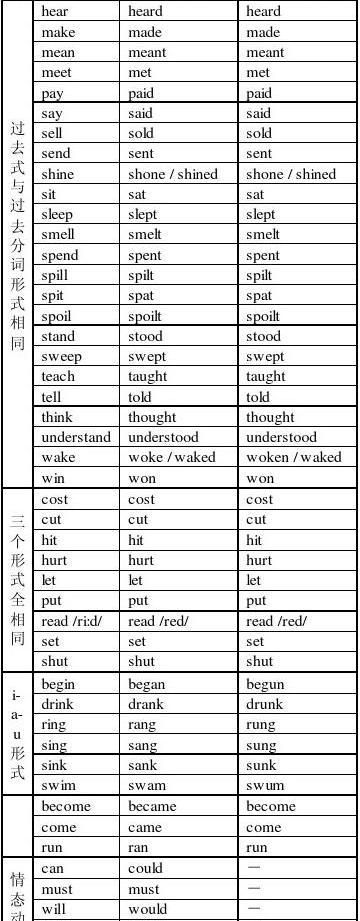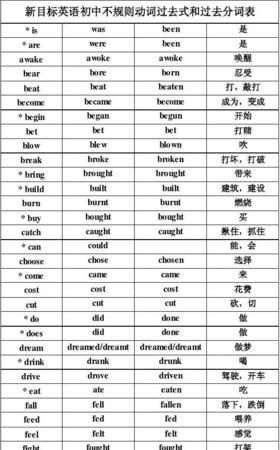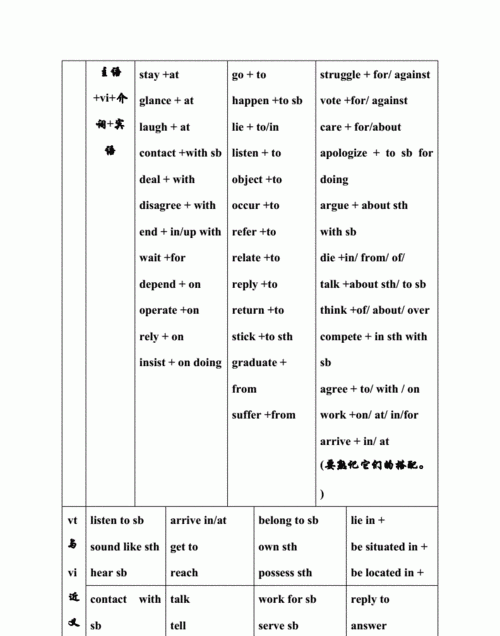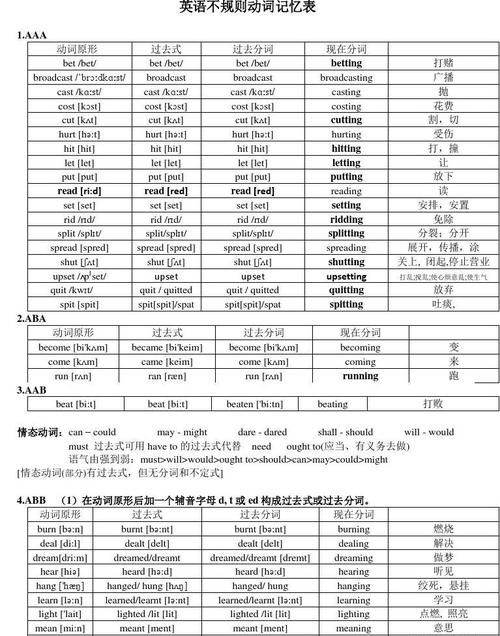本文目录
中考英语动词的分类
第一方面:按词义和句中的作用,动词可以分为四类。见下表。
类别
特点
意义
举例
实义动词 (vt. vi.)
及物动词跟宾语
须跟宾语一起才能表达完整的意思
I have a book..
不及物动词不能直接接宾语
能独立作谓语
She always comes late.
系动词(link-v)
跟表语
不能独立做谓语,跟表语构成完整意思
I am a student.
助动词(aux. v.)
跟动词原形或分词(无词汇意义)
不能独立做谓语,跟主要动词构成谓语,表示疑问,否定及各种时态
He doesn’t speak Chinese.
I am watching TV.
情态动词 (mod. v.)
跟动词原形(有自己的词汇意思)
不能独立做谓语。表示说话人语气、情态,无人称和数的变化
We can do it by ourselves.
That would be better.
第二方面:短语动词,短语动词是由一些动词和其它词构成短语,表达一个完整的意思。其构成方式如下。
构成方式
举例
动词+介词
Look at, look after
动词+副词
Give up, put into
动词+副词+介词
Catch up with, look down upon
动词+名词+介词
Take care of, pay attention to
Be+形容词+介词
Be proud of, be afraid of
复杂结构
Make up one’s mind, wind one’s way
第三方面:按动词的形式可以分为谓语动词和非谓语动词。
1、谓语动词
形式
意义
举例
人称
与主语在人称一致
I am reading now. 第一人称
数
与主语在数上一致
He writes well. 第三人称单数
时态
表示动作发生的时间
He wrote a letter to me last month. 过去时态
语态
主语是动作的发生者或者承受者
We study English.主动
The road was filled with rubbish. 被动
语气
说话人表达事实、要求、愿望等
He has flown to America. 事实
I wish I could fly to the moon some day. 愿望
2、非谓语动词
形式
意义
用途
举例
不定式
起形容词和名词作用
可作主语、表语、宾语、定语、状语
It takes me 20 minutes to go to school.
动名词
起名词作用
作主语和宾语
She likes reading.
分词
现在分词
起形容词、副词作用,表主动
作表语、定语、状语、宾语补足语
The cup is broken
过去分词
起形容词、副词作用,表被动
The steam is seen rising from the wet clothes.

初中英语动词固定搭配大全
1. allow sb. to do sth. 允许某人去做某事
My father allowed me to go out for a walk after finishing my homework.
2. asked sb. (not) to do sth. 叫某人做事某事(叫某人不要去做某事)
My father asked me to study hard. He asked me not to swim alone.
be asked to do sth. 被叫去做某事/被邀请去做某事
I was asked to have a dinner with them yesterday.
3. be afraid to do sth. 害怕做某事 She is afraid to ask me questions.
4. be afraid of doing sth. 害怕做某事 I am afraid of going out at night.
5. be afraid of sth. 害怕某物 He is afraid of snakes.
6. be amazed to do sth. 对做某事感到惊讶 He was amazed to meet the girl there.
be amazed at sth. 对某事感到惊讶 they were amazed at the news
7. be busy doing/with sth. 忙于做某事 (常考) e.g: I was busy washing my car at that time. 那时候我正忙于清洗我的车子。 I am busy with my work.
8. be coming/going/leaving/fiying/moving/dying(某些位移动词用进行时态时表将来) the bus is coming/the dog is dying.
9. be excited to do sth. 对做……感到兴奋 Jacky was excited to travel there by plane. be excited at sth. Lily was excited at his words. be excited about doing sth. he was excited about passing the exam without going overing books.
10. be frightened to do sth. 害怕去做某事 Sam is frightened to ride a horse.
11. be glad/happy to do sth. 高兴去做某事 she is happy to clean the blackboard with me. be pleased to do sth. 高兴做某事 she was pleased to help the old man yesterday be pleased with sth. 对某事感到高兴/满意 the teacher was pleased with my answer.
12. be interested in sth./doing sth. 对某事感兴趣/对做某事感兴趣 she is interested in swimming in the river. My brother is interested in Chinese.
13. be/get ready for/to do sth. Be ready for sth. 为某事做好了准备 We are ready for the exam. Be ready to do sth. 为做某事做好了准备We are ready to have a birthday party for her. get ready for sth.为某事在做准备 We are getting ready for the exam.
get ready for sth. 为做某事而做准备
13. be sorry to do sth. 对做某事感到抱歉
14. be surprised to do sth. 对做某事感到惊奇 be surprised at sth. 对某事感到惊奇
15. be worth doing sth. 值得做某事 (worth 后接动词-ing形式,常考)
16. begin to do sth. begin/start to do/doing sth.
17. can/be able to afford (to buy) sth. 有能力购买(供)……
18. can/may/must do sth. could/would/should/might do sth.
19. can’t wait to do sth. 迫不急待地去做某事
20. decide to do sth. 决定去做某事 make up one’s mind to do sth. 下决心去做某事 (常考) make a decision to do sth. 对做某事作出决定
21. deserve to do sth. 值得/应该做……
22. encourage sb. to do sth. 鼓励某人去做某事
23. enjoy doing sth. 乐意去做某事
24. expect (sb.) to do sth. 期望去做某事
25. fail to do sth. 做某事失败 succeed doing sth. 成功做了某事
26. finish doing sth. 做完某事(后接动词-ing形式) (常考)
27. follow sb to do sth. 跟随某人去做某事
28. get sb. to do sth. make sb. do sth. let sb. do sth.
29. get/have a chance to do sth. 得到一个做某事的机会
30. give/pass/show/lend/sell sb. sth./ sth. to sb. buy/get/bring sb. sth. / sth. for sb.
31. go on to do sth. 继续做事(常考) go on doing sth. 继续做事(常考)
32. hate to do/doing sth. 讨厌/不喜欢做某事
33. have fun doing sth.
34. have problems doing sth. 做某事遇到困难
35. have sb. do sth. have sth. done have sth. to do 有事要做
36. hear sb. do sth. 听到某人做某事(后接动词原形,常考) hear sb. doing sth. 听到某人正在做某事(常见)
37. help to do sth. 帮忙做某事help sb. (to) do sth. 帮助某人做某事
38. hope/wish to do sth. 希望做某事 wish sb. to do sth. 希望某人做某事
39. I t seems that 这像是……(后接从句) seem to do sth. seem +adj.
40. It’s + adj.+(for sb.) to do sth.
It’s + adj. +(of sb.) to do sth e.g: It’s glad for him to hear the news.
41. It takes sb. some time/money to do sth. 花费某人多长时间做某事(常考)
42. pay …for… cost spend…on….. it take …to do sth.
43. It’s best for sb to do sth.. 对某人来说做某事是最好的
had better do sth. 最好做某事 (注意had没有时态和人称的变化,better后接动词原形)
44. It’s time for sb. to do sth. 是某人做某事的时候了
45. keep (on)doing sth. 坚持做某事(常考) keep sb. doing sth. 让某人做某事(常考)
keep sb. from doing sth. 阻止某人做某事(常考) keep sb./ sth. +adj.
keep the book for 2 days 借这本书两天(不要用borrow或lend)
46. learn to do sth. 学做某事 learn sth. from sb. 向某人学习
47. like to do/doing sth. 喜欢做某事 like sb. to do sth. 喜欢某人做某事
48. need to do sth. need doing sth./to be done need sth . needn’t do sth.
49. prefer to do sth. rather than do sth. 宁愿……而不愿……(常考)
prefer doing sth. to doing sth. 喜欢做……胜过做……
e.g: I prefer reading books to going shopping. 比起购物来,我更爱读书。
prefer to do sth. 喜欢(爱)做某事
50. refuse to do sth. 拒绝做……
51. remember/forget to do sth. 记得/忘记做某事 remember/forget doing sth. 记得/忘记做过某事
52. see sb. do sth. 看见某人做某事 (结果)
see sb. doing sth. 看见某人正在做某事(正在进行中)
be seen to do sth. 做某事被看见
53. something to eat/drink 一些吃/喝的东西 (词不定式放在something等后修饰这些词)
e.g: I need something to eat. 我要一些吃的东西。
54. spend some time (in)doing sth. /on sth. 花费时间做某事(注意动词要用ing形式)(常考)
spend some money on sth./ doing sth. 买……花了多少钱
55. Sth. is hard/difficult/easy to do. 做好某事很难/容易
56. stop to do sth. 停下来去某事(两件事) (常考)
stop doing sth. 停止做某事(一件事) (常考)
stop sb. (from) doing sth. 阻止某人做某事(常考)
57. take turns to do sth. 轮流做……
58. tell sb. (not) to do sth. 叫某人去(不要)做某事 be told to do sth. 被告知不要做某事
59. There is no need (for sb.) to do sth. 对某人来说没必要做某事
60. There is no time (for sb.) to do sth.
have no time to do sth. 没时间做某事
61. too…(for sb.) to …太……以致不能……
so… that… not… enough to do
e.g: The boy is too young to go to school. 那男孩太小了以致不能上学。
62. try/do one’s best to do sth. 尽力去做某事 try to do sth. 试着(图)做某事
63. used to do sth. 过去常做某事( used to be + adj./ a +n)
e.g: Mr. wang used to be a teacher worker. 王先生过去是一位工人。
I used to live in the country. 过去我住在农村
64. want/would like to do sth. 想做…… want/would like sb. to do sth. 想某人做……
feel like doing sth. 喜爱做某事(注意like后接动词ing形式
65. warn sb. (not) to do sth. 警告某人做某事(或不要做某事
66. Why don’t you do sth.? Why not do sth ?
表示建议的句型还有:What How about……? (如果是动词,要用ing形式)
Shall we……?
67. Would you like (sb.) to do sth.? Yes, I’d love to.
68. Would you mind doing sth.? 你介意做某事吗?
Never mind/Not at all/of course not/certainly not. (从不介意/一点也不介意/当然不会了)
69. Would you please (not) do sth. 你可不可以不做……?
70. finish doing sth. enjoy doing sth. practise doing sth. be good at doing sth. be good at doing sth. thank you f
or doing sth. stop doing sth. be good at doing sth. give up doing sth mind doing sth stop sb from doing sth go on doing sth be busy doing sth see/hear/watch sb doing sth feel like doing sth hate doing sth like doing sth do well in doing sth be afraid of doing sth be interested in doing sth make a contribution to sth/doing sth
71. 非延续性动词(终止性动词)
1) buy---have(has)had 2) borrow---have(has)kept 3) leave---have(has)been away
4) go ---have(has)been away/in… 5) come ---have(has)here/in…
6) die ---have(has)been dead 7) join---have(has)been a member of/in…
8) begin---have(has)on 9) stop---have(has)been over
例如: 他的狗死了3天了.: His dog has been dead for three days. It is three days since his dog died. His dog died three days ago.
72. 感官动词:(主动语态不带to)1.hear/see/watch sb do sth 或 2. hear/see/watch sb doing sth
1)We often hear him sing the song.
2)I saw him swimming in the river just now.
被动语态带to:
He is often heard to sing the song.
役使动词: (主动语态不带to) make/let sb do sth.
His father often makes him do this and that.
被动语态带to:
He is often made to do this and that by his father.

初中英语被动语态的用法归纳
过去式 例 be:was/were do:did have:had……
过去进行时 例 was going / were doing……
一般现在时 例 go/gose do/dose……
现在进行时 例 is doing/ is watching……
将来时 例 is going to do/ will.../is doing ……
过去将来时 例 would/ was going to be ……
初中大概就这么几个用法

初中英语词性分类归纳
十大词类:
1,名词,Nouns (n.) 表示人或事物的名称 box, pen,tree,apple
2,代词,Pronouns (pron.)代替名词、数词、形容词We, this, them,myself
3,形容词, Adjectives(adj.) 用来修饰名词,表示人或事物的特征 good, sad, high, short
4,数词,Numerals(num.)表示数目或顺序 one,two, first
5,动词,Verb (v.) 表示动作或状态 Jump,sing,visit
6,副词,Adverbs(adv.) 修饰动、形、副等词,表示动作特征 there,widely,suddenly
7,冠词,Articles (art.) 用在名词前,帮助说明名词所指的范围 a, an, the
8,介词,Prepositions (prep.) 用在名词或代词前,说明它与别的词的关系 in,on,down,up
9,连词,Conjunctions (conj.) 表示人或事物的名称if,because,but
10,感叹词, Interjections (int.) 代替名词、数词、形容词等 oh,hello,hi,yeah
vt.是及物动词,vt.后必须跟宾语:sing a song
vi.是不及物动词,vi.后不直接带宾语或不带宾语:jump high

以上就是关于初中英语动词分类及用法 ,中考英语动词的分类的全部内容,以及初中英语动词分类及用法 的相关内容,希望能够帮到您。

